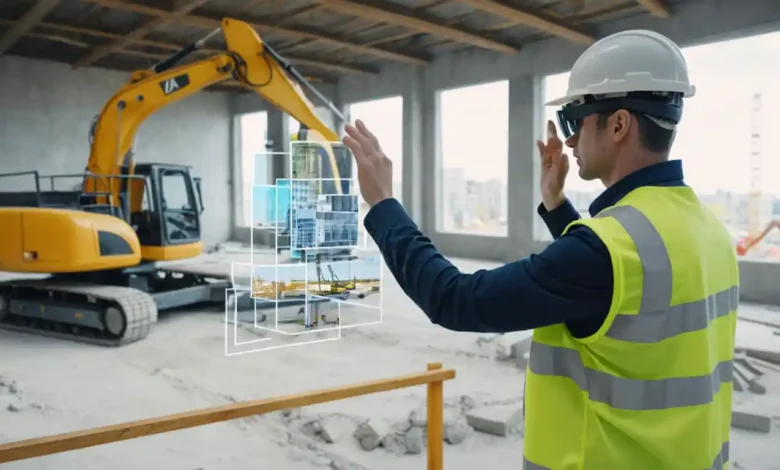What is Construction Technology? Key Trends & Innovations

In today’s fast-evolving world, the construction industry is undergoing a digital revolution. From smart tools to AI-powered systems, construction technology is reshaping how we design, plan, and build our homes, offices, and infrastructure.
But what is construction technology, really? How does it apply in civil engineering? What are the tools and examples that define it? Whether you’re a student, a job seeker, or a construction enthusiast, this guide will walk you through the key aspects of construction tech — its applications, benefits, tools, and career potential.
What is Construction Technology?
Simply put, construction technology refers to the collection of innovative tools, machines, software, and methods used to improve the efficiency, accuracy, and safety of construction projects. It combines engineering knowledge with digital tools to streamline building processes — from planning to final execution.
If you’re asking, what is construction technology in civil engineering, it’s the use of advanced tools like Building Information Modeling (BIM), drones, 3D printing, and robotics to support large-scale infrastructure projects such as roads, bridges, and buildings.
In short, what is construction technology? It’s the smart way to build — faster, safer, and better.
Why is Construction Technology Important?
The importance of construction technology cannot be overstated. It reduces waste, cuts down costs, ensures worker safety, and enhances quality control. For example, using digital blueprints and 3D models minimizes design errors and improves communication among project teams.
Additionally, with the U.S. facing labor shortages in construction, technology is helping fill the gaps through automation and efficient scheduling systems.
10 Examples of Construction Technology in Action
Curious to know how this works in real life? Here are 10 examples of construction technology being used across the industry today:
Drones – Used for aerial site surveys and progress tracking.
3D Printing – Speeds up construction and reduces material waste.
Building Information Modeling (BIM) – Digitally represents building designs.
Construction Robotics – Automates repetitive tasks like bricklaying or demolition.
Augmented Reality (AR) – Enhances on-site visualization.
Prefabrication and Modular Construction – Builds components off-site.
Construction Management Software – Streamlines scheduling and budgeting.
Wearable Tech – Monitors worker health and safety.
Laser Scanning – Captures precise measurements.
Self-healing Concrete – A futuristic material that repairs itself.
These tools are revolutionizing construction from the ground up. Many of these innovations are now covered in academic resources like construction technology PDF notes used by engineering students across the USA.

Careers and Salaries in Construction Technology
Thinking about a career in this field? You’re not alone. What is construction technology jobs like? They include roles such as:
Construction Technologist
BIM Coordinator
Site Engineer
Project Manager
Robotics Operator
Digital Twin Specialist
And they pay well! The average construction technology salary in the U.S. ranges from $60,000 to $110,000 annually, depending on your skills and experience. High-demand locations like California, Texas, and New York offer even more competitive salaries.
Education: What is a Construction Technology Degree?
A construction technology degree is your gateway into this exciting world. Offered by many technical colleges and universities, the program covers:
Civil engineering fundamentals
Design and drafting (CAD/BIM)
Project management
Safety protocols
Sustainable construction methods
Graduates can pursue internships or jobs in commercial, residential, or industrial construction firms. The U.S. Bureau of Labor Statistics forecasts strong job growth in this field over the next decade.
Essential Construction Technology Tools
To succeed in the construction tech space, professionals rely on various construction technology tools, including:
AutoCAD and Revit for design
Procore and PlanGrid for project management
Trimble and Topcon for laser-based measurement
Smart wearables for safety tracking
AR/VR headsets for real-time visualization
Familiarity with these tools can give you a serious edge in the industry.
The Link Between Construction and Manufacturing Technology
Many people ask, what is manufacturing technology, and how does it differ from construction tech?
Manufacturing technology focuses on producing goods in a factory setting, using robotics and automation. While construction technology applies to on-site building processes, both fields share a common goal — increasing efficiency through innovation.
In fact, techniques like prefabrication and modular building are blurring the lines between the two, combining the speed of manufacturing with the customization of construction.
Pro Tips for Embracing Construction Technology
Want to stay ahead in the construction game? Here are a few practical tips:
Stay updated – Follow trends on platforms like LinkedIn or industry blogs.
Get certified – Courses in BIM, AutoCAD, or OSHA safety can boost your profile.
Network – Attend trade shows or join professional groups like AGC of America.
Practice – Try free trials of project management tools or AR apps.
Read up – Download construction technology PDF notes or follow YouTube tutorials to strengthen your skills.

Frequently Asked Question
What is construction technology and how does it impact the industry?
Construction technology refers to the tools, machinery, software, and techniques used to improve the efficiency and effectiveness of construction projects. It impacts the industry by reducing costs, improving safety, accelerating project timelines, and enabling the construction of more sustainable and energy-efficient structures.
What are some examples of construction technology?
Examples of construction technology include 3D printing for building structures, drones for surveying, Building Information Modeling (BIM) for design visualization, robotics for automating tasks, and modular construction methods that allow for faster assembly of prefabricated units.
What is a construction technology degree and what career opportunities does it offer?
A construction technology degree is a specialized program that equips students with the skills and knowledge needed to manage and execute modern construction projects. It covers topics such as project management, civil engineering, and the latest technological tools. Graduates can pursue careers as construction managers, civil engineers, project coordinators, and more, in both private and public sectors.
Why is construction technology important in civil engineering?
In civil engineering, construction technology enhances project design, management, and execution. It ensures the use of efficient materials, precise planning, and accurate construction techniques. By adopting advanced construction technologies, engineers can create safer, more durable, and sustainable infrastructures, reducing errors and improving project outcomes.
What are the job prospects and salary in construction technology?
With the rise of new technologies in construction, there is a growing demand for professionals skilled in construction technology. Job roles include construction managers, engineers, and BIM specialists. Salaries in this field vary depending on the role and location, but with India’s expanding infrastructure projects, the job market is expected to remain strong, offering competitive salaries and opportunities for career advancement.
Conclusion
So, what is construction technology? It’s the blend of smart tools, data-driven decision-making, and future-forward thinking that’s transforming how we build the world.
From students earning a construction technology degree to skilled professionals using drones or 3D printers on-site, this field is rich with opportunity and innovation. Whether you’re exploring construction technology jobs or just curious about 10 examples of construction technology, one thing is clear the future of construction is tech-driven.
Stay curious, keep learning, and don’t be afraid to embrace the tools that are shaping tomorrow’s skylines.





